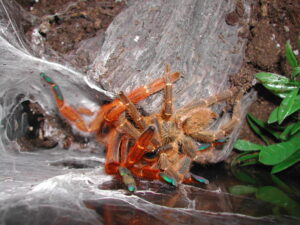When the tarantulas reach maturity depends on what species it is, but males usually mature faster then females. Poecilotheria males reaches maturity in just 8-10 months (in captivity) and some takes several years to reach maturity (e.g. Pelinobius muticus). When the male have reached that age they molt for the last time and after this molt the embolus are formed on the pedipalps (formed like a pair of ”boxing gloves”) and in some species hooks are visible on their first pair of legs to hold the females fangs in control. Some species doesn’t get the hooks and the breeding behaviour is not the same for all species.

The embolus and the hook are circled
[youtube https://www.youtube.com/watch?v=A5cj5Ug9SoY]
A short time after the final molt the males create a web called ”sperm web” and on this web he drops his sperm which he then drawn into the embolus.
After locating a female burrow he start to drum gently on the webbing at the entrance of the burrow. If the female are responsive to mating she will emerge and tap her legs. After closely checking her intensions he approach her and carefully stroke her legs. If she still are in mating mood she will spread her chelicera and the male can hook her fangs up with the hooks (not all species have hooks) on his legs and then he bend her backwards. After locating her epigastric area with the pedipalps he releases his sperm into her. When he is done he must unhook himself from her fangs and if his lucky he runs away safe – if something goes wrong he can end up as lunch. Usually a couple of months after the mating the male dies.

Pterinochilus murinus mating
After c:a 4-6 weeks, depending on species, the female spins a web and on top of this she lays her eggs a couple of hundred to several thousand depanding on species. Some species can lay up to 2500 eggs! When the eggs are layed onto the web she fertilize the eggs by dropping the sperm she have in the spermatheca on them. When shes done she rolls the net into a ball and spins silk to a neat little cocoon. This cocoon she will hold on to with her pedipalps and carring it around, moves it to a proper place with the right temperature and humidity.

Lasiodora parahybana female laying eggs
African species attach the eggsack in a proper spot inside the burrow. After some time the small postembryos are hatched inside the cocoon but the spiderlings are not leaving it just yet. First they molt for the first time inside the cocoon. The spiderlings are small and white or light yellow when they finally leaves the cocoon.They get the adult coloration in 1-2 years, depending on species. Some species grow rapidly for ex. Theraphosa blondi spiderlings which can almost double the size between each molt.

Lasiodora parahybana with eggsack
There has been successful breeding of several species for years. To know the gender of the spiders makes it easier when planning to breed them. You can sex a spider by study the inside of a exuvium closely. In some species its possible to look on the underside of the abdomen if its a female (a small bump at the genital opening) but this method are not 100%.
Read more in Sexing
